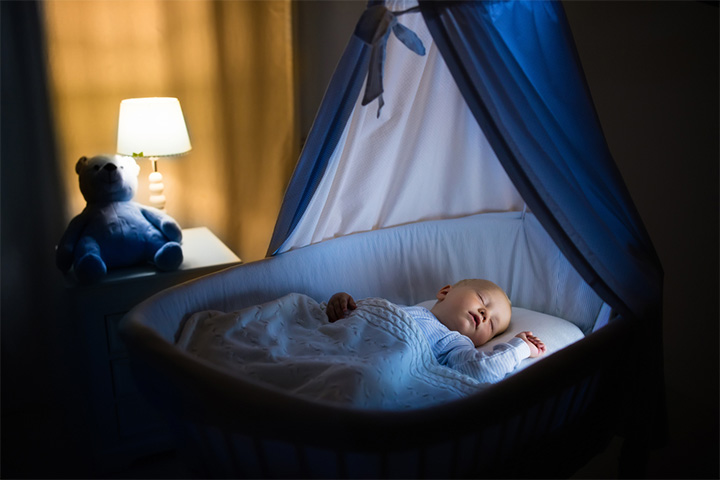
Image: Shutterstock
The first year of a baby’s life is full of new learning experiences as they hit many milestones, one of which is learning how to sleep on their own. Most parents can’t wait until their little one can sleep through the night, but there’s a long way to go before that becomes a reality. It may take some time for new parents to adjust to their newborn’s sleep schedule (or lack thereof). Good sleep is essential for babies as it directly affects their brain development, behavior, emotions, and immune system. Ensuring that your baby has a good sleep routine and gets the right amount of naps during the day can be a daunting task.
An easy solution that most parents turn to is sleep training. This entails teaching your baby to fall asleep without your help by creating rituals or habits around bedtime. The idea is to put your drowsy baby in the cradle and watch them drift off to sleep without being rocked, swayed, cuddled, shushed, or nursed. This also ensures that they fall back asleep when they wake up in the middle of the night. However, with so many options in various sleep training methods, parents tend to overcomplicate the simple process of putting their baby to bed.
Sleep patterns tend to change drastically during the first year of a baby’s life. This brings up the question: How much should my child sleep? The number of hours of sleep and the duration of sleep periods through the day and during the night change as your baby grows. For instance, it’s normal for a baby that is 0-3 months to sleep anywhere between 14-17 hours a day, broken into shorter periods to accommodate diaper changes and feeding sessions. By the time they reach 3-5 months, the number of hours drops to 12-15 hours with extended sleep periods, eventually leading to it bulking up as they learn to sleep through the night upon reaching 6 months. They must be able to sleep through the night by their first birthday so that their sleep patterns become similar to that of adults.
So, here are 5 alternatives to consider while establishing your baby’s sleep routine:
1. Set A Schedule
Image: Shutterstock
Babies often take several naps throughout the day and struggle to sleep undisturbed through the night. Tweaking their nap times during the day will make a huge difference in their sleep schedule. Setting a predictable and consistent bedtime routine will help your baby gradually fall asleep of their own accord. Let your little one get accustomed to sleeping at set times during the night and day to ensure an improved sleep experience.
2. Create A Bedtime Routine
Image: Shutterstock
Most babies take to things that they find consistent and familiar. Come up with a routine or a small list of things to do to get your little one settled into sleep. This may entail a warm bath, a relaxing full-body massage, or good old aromatherapy. Use a diffuser to emit lavender or any other calming scent to put your baby in the mood for a long, fuss-less night of sleep. Regardless of what you do, it helps to have an established nighttime routine with your baby before you put them down.
3. Co-sleeping
Image: Shutterstock
Co-sleeping is when your baby sleeps close to one or both of the parents instead of sleeping in another room. This does not necessarily mean that they share the same bed as you. Moving them into your room in their crib, bassinet, or co-sleeper bed can benefit you and the baby. This is a popular option as it achieves the common goals of sleep training and a consistent sleep time routine, thus ensuring quality sleep for you and your baby. However, if your baby is consistently having trouble falling asleep, it is advisable to see a pediatrician to figure out if there are other underlying issues that are hindering your baby’s ability to sleep.
4. Do Activities That Lull Your Baby To Sleep
Image: Shutterstock
It may be beneficial to incorporate certain activities that stimulate your baby’s need to fall asleep. This can include reading a book in a mellow tone of voice or singing them a lullaby to help them fall asleep. Associating a certain song with naptime can also have this desired effect. Creating a dimly lit and quiet environment can help induce sleep as well.
5. Read Informative Books On Alternatives For Sleep Training
It is easy to get caught up and overwhelmed with all the tips from family and friends about how best to sleep-train your child. But here are two books that will help you decide what you want your baby’s sleep routine to look like:
- How Babies Sleep: The Gentle Science-Based Method to Help Your Baby Sleep By Sophia Axelrod
Sophia Axelrod wrote this book to provide caregivers with tips on sleep training their babies. It falls under the gentle, attached parenting style.
- The No-Cry Sleep Solution: Gentle Ways to Help Your Baby Sleep Through the Night By Elizabeth Pantley
This book is for those parents and caregivers who struggle with sleep training because they can’t bear to hear their baby cry. The Gentle Removal Plan outlined in this book encourages parents to slowly remove soothing and comforting articles from their baby’s environment one at a time. This may be a baby bottle or a pacifier until their baby can sleep independently.
It is important to keep in mind that teaching your baby to put themselves to sleep will take time and effort. So don’t be discouraged if it doesn’t happen right away. It will get better gradually, and soon you and your baby will be sleeping through the night!
















